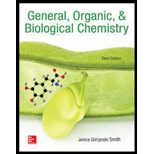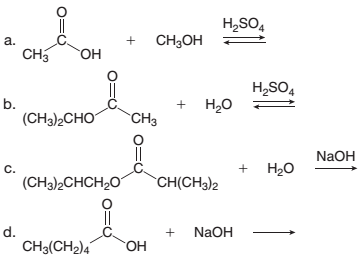
EBK GENERAL, ORGANIC, & BIOLOGICAL CHEM
3rd Edition
ISBN: 9781259298424
Author: SMITH
Publisher: VST
expand_more
expand_more
format_list_bulleted
Textbook Question
Chapter 17, Problem 17.89P
Draw the products formed in each reaction.

Expert Solution & Answer
Want to see the full answer?
Check out a sample textbook solution
Students have asked these similar questions
Using the following two half-reactions, determine the pH range in which $NO_2^-\ (aq)$ cannot be found as the predominant chemical species in water.* $NO_3^-(aq)+10H^+(aq)+8e^-\rightarrow NH_4^+(aq)+3H_2O(l),\ pE^{\circ}=14.88$* $NO_2^-(aq)+8H^+(aq)+6e^-\rightarrow NH_4^+(aq)+2H_2O(l),\ pE^{\circ}=15.08$
Indicate characteristics of oxodec acid.
What is the final product when hexanedioic acid reacts with 1º PCl5 and 2º NH3.
Chapter 17 Solutions
EBK GENERAL, ORGANIC, & BIOLOGICAL CHEM
Ch. 17.1 - Draw out each compound to clearly show what groups...Ch. 17.1 - Prob. 17.2PCh. 17.1 - (a) Label each functional group in lisinopril, a...Ch. 17.2 - Give the IUPAC name for each compound. a. b. c.Ch. 17.2 - Give the structure corresponding to each IUPAC...Ch. 17.2 - Prob. 17.6PCh. 17.2 - Prob. 17.7PCh. 17.2 - Prob. 17.8PCh. 17.2 - Prob. 17.9PCh. 17.2 - Prob. 17.10P
Ch. 17.2 - Prob. 17.11PCh. 17.3 - Which compound in each pair has the higher boiling...Ch. 17.4 - Prob. 17.13PCh. 17.5 - In addition to ethyl butanoate (Section 17.5),...Ch. 17.6 - Prob. 17.15PCh. 17.6 - Prob. 17.16PCh. 17.6 - Prob. 17.17PCh. 17.6 - Prob. 17.18PCh. 17.6 - Prob. 17.19PCh. 17.7 - Prob. 17.20PCh. 17.7 - Ibuprofen is another pain reliever that is a...Ch. 17.8 - Prob. 17.22PCh. 17.8 - Prob. 17.23PCh. 17.8 - Prob. 17.24PCh. 17.8 - Prob. 17.25PCh. 17.8 - Prob. 17.26PCh. 17.9 - Prob. 17.27PCh. 17.9 - Prob. 17.28PCh. 17.9 - Prob. 17.29PCh. 17.9 - Prob. 17.30PCh. 17.9 - Prob. 17.31PCh. 17.9 - Prob. 17.32PCh. 17.10 - Prob. 17.33PCh. 17.10 - Prob. 17.34PCh. 17.10 - Prob. 17.35PCh. 17.11 - Prob. 17.36PCh. 17 - Prob. 17.37PCh. 17 - Prob. 17.38PCh. 17 - Prob. 17.39PCh. 17 - Prob. 17.40PCh. 17 - Prob. 17.41PCh. 17 - Prob. 17.42PCh. 17 - Prob. 17.43PCh. 17 - Prob. 17.44PCh. 17 - Prob. 17.45PCh. 17 - Prob. 17.46PCh. 17 - Prob. 17.47PCh. 17 - Give an acceptable name for each ester. a. CH3CO2(...Ch. 17 - Prob. 17.49PCh. 17 - Prob. 17.50PCh. 17 - Prob. 17.51PCh. 17 - Give an acceptable name for each compound.
a.
b....Ch. 17 - Prob. 17.53PCh. 17 - Draw the structure corresponding to each name. a....Ch. 17 - Draw the structure corresponding to each name. a....Ch. 17 - Draw the structure corresponding to each name. a....Ch. 17 - Prob. 17.57PCh. 17 - Prob. 17.58PCh. 17 - Prob. 17.59PCh. 17 - Prob. 17.60PCh. 17 - Prob. 17.61PCh. 17 - Prob. 17.62PCh. 17 - Prob. 17.63PCh. 17 - Prob. 17.64PCh. 17 - Prob. 17.65PCh. 17 - Prob. 17.66PCh. 17 - What ester is formed when butanoic acid...Ch. 17 - Prob. 17.68PCh. 17 - Prob. 17.69PCh. 17 - Prob. 17.70PCh. 17 - Prob. 17.71PCh. 17 - Prob. 17.72PCh. 17 - Prob. 17.73PCh. 17 - Prob. 17.74PCh. 17 - Prob. 17.75PCh. 17 - Prob. 17.76PCh. 17 - Prob. 17.77PCh. 17 - Prob. 17.78PCh. 17 - Prob. 17.79PCh. 17 - Prob. 17.80PCh. 17 - Prob. 17.81PCh. 17 - Prob. 17.82PCh. 17 - Prob. 17.83PCh. 17 - Prob. 17.84PCh. 17 - Prob. 17.85PCh. 17 - Prob. 17.86PCh. 17 - What is the difference between saponification and...Ch. 17 - You have now learned three different types of...Ch. 17 - Draw the products formed in each reaction.
Ch. 17 - Prob. 17.90PCh. 17 - Answer the following questions about A, depicted...Ch. 17 - Answer the following questions about B, depicted...Ch. 17 - Prob. 17.93PCh. 17 - Prob. 17.94PCh. 17 - Prob. 17.95PCh. 17 - Prob. 17.96PCh. 17 - Prob. 17.97PCh. 17 - Prob. 17.98PCh. 17 - Prob. 17.99PCh. 17 - Prob. 17.100PCh. 17 - Prob. 17.101PCh. 17 - Prob. 17.102PCh. 17 - Prob. 17.103CPCh. 17 - Lactams can be hydrolyzed with base, just like...
Knowledge Booster
Learn more about
Need a deep-dive on the concept behind this application? Look no further. Learn more about this topic, chemistry and related others by exploring similar questions and additional content below.Similar questions
- What is the final product when D-galactose reacts with hydroxylamine?arrow_forwardIndicate the formula of the product obtained by reacting methyl 5-chloro-5-oxopentanoate with 1 mole of 4-penten-1-ylmagnesium bromide.arrow_forwardIn the two chair conformations of glucose, the most stable is the one with all the OH groups in the equatorial position. Is this correct?arrow_forward
- please help me with my homeworkarrow_forwardhelparrow_forwardThe temperature on a sample of pure X held at 1.25 atm and -54. °C is increased until the sample boils. The temperature is then held constant and the pressure is decreased by 0.42 atm. On the phase diagram below draw a path that shows this set of changes. pressure (atm) 2 0 0 200 400 temperature (K) Xarrow_forward
- QUESTION: Answer Question 5: 'Calculating standard error of regression' STEP 1 by filling in all the empty green boxes *The values are all provided in the photo attached*arrow_forwardpressure (atm) 3 The pressure on a sample of pure X held at 47. °C and 0.88 atm is increased until the sample condenses. The pressure is then held constant and the temperature is decreased by 82. °C. On the phase diagram below draw a path that shows this set of changes. 0 0 200 temperature (K) 400 аarrow_forwarder your payment details | bar xb Home | bartleby x + aleksogi/x/isl.exe/1o u-lgNskr7j8P3jH-1Qs_pBanHhviTCeeBZbufuBYT0Hz7m7D3ZcW81NC1d8Kzb4srFik1OUFhKMUXzhGpw7k1 O States of Matter Sketching a described thermodynamic change on a phase diagram 0/5 The pressure on a sample of pure X held at 47. °C and 0.88 atm is increased until the sample condenses. The pressure is then held constant and the temperature is decreased by 82. °C. On the phase diagram below draw a path that shows this set of changes. pressure (atm) 1 3- 0- 0 200 Explanation Check temperature (K) 400 X Q Search L G 2025 McGraw Hill LLC. All Rights Reserved Terms of Use Privacy Cearrow_forward
arrow_back_ios
SEE MORE QUESTIONS
arrow_forward_ios
Recommended textbooks for you
 Organic Chemistry: A Guided InquiryChemistryISBN:9780618974122Author:Andrei StraumanisPublisher:Cengage Learning
Organic Chemistry: A Guided InquiryChemistryISBN:9780618974122Author:Andrei StraumanisPublisher:Cengage Learning Organic ChemistryChemistryISBN:9781305580350Author:William H. Brown, Brent L. Iverson, Eric Anslyn, Christopher S. FootePublisher:Cengage Learning
Organic ChemistryChemistryISBN:9781305580350Author:William H. Brown, Brent L. Iverson, Eric Anslyn, Christopher S. FootePublisher:Cengage Learning

Organic Chemistry: A Guided Inquiry
Chemistry
ISBN:9780618974122
Author:Andrei Straumanis
Publisher:Cengage Learning

Organic Chemistry
Chemistry
ISBN:9781305580350
Author:William H. Brown, Brent L. Iverson, Eric Anslyn, Christopher S. Foote
Publisher:Cengage Learning
GCSE Chemistry - Differences Between Compounds, Molecules & Mixtures #3; Author: Cognito;https://www.youtube.com/watch?v=jBDr0mHyc5M;License: Standard YouTube License, CC-BY